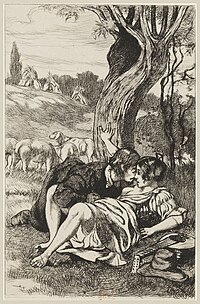
Photo from wikipedia
Our objective was to estimate genetic parameters, and genetic and phenotypic trends for bodyweight (BW; measured at birth, 120, 205 (weaning age), 365, 450 and 550 days of age), scrotal… Click to show full abstract
Our objective was to estimate genetic parameters, and genetic and phenotypic trends for bodyweight (BW; measured at birth, 120, 205 (weaning age), 365, 450 and 550 days of age), scrotal circumference, and visual appraisal scores of body conformation in Guzerat cattle. Data regarding body structure, finishing precocity, muscling, sheath and navel, breed characteristics, limbs (soundness of feet and legs), and sexuality, which were visually appraised, were obtained from the Brazilian Association of Zebu Breeders, recorded between 1970 and 2013 in five Brazilian states. Variance components and heritability were estimated by using linear animal (for continuous variables) and threshold (for categorical variables) models using Bayesian inference. Genetic and phenotypic trends were obtained by regressing the average annual genetic value relative to animal’s birth year. The direct heritability values for BW were high, ranging from 0.38 to 0.45, whereas the maternal effect was responsible for 17–23% of the phenotypic variation. For scrotal circumference, the direct heritability values were median with values ranging from 0.08 and 0.15, whereas for visual appraisal scores, the values were median to high (0.07–0.18). Higher response to selection for BW traits is expected for those with moderate to high heritabilities. The estimated genetic trends indicated favourable changes for BW with average annual changes of 396, 2948, 3388, 5808, 8184, and 8096 g for BW at the respective ages. The genetic values were decreasing over the years for scrotal circumference, body structure, finishing precocity, muscling, and sheath and navel. Therefore, a longer evaluation period should be utilised to assess these traits as little time has elapsed from the beginning of the selection until the time of the present study.
Journal Title: Animal Production Science
Year Published: 2017
Link to full text (if available)
Share on Social Media: Sign Up to like & get
recommendations!